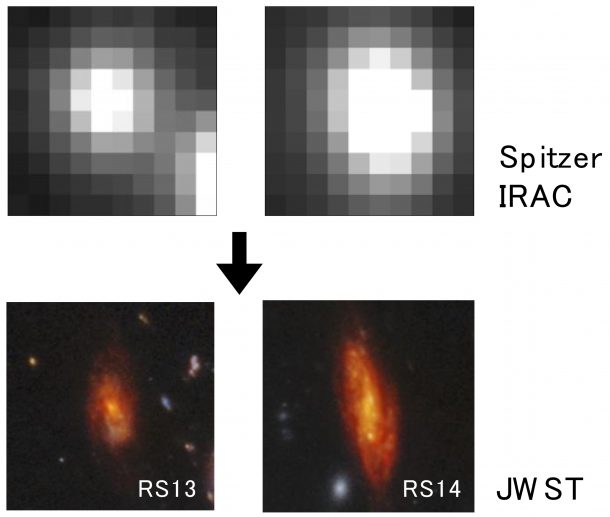Spiral galaxies like the Milky Way are believed to be one of the most common types of galaxies in the universe. They tend to be active and full of star formation, which makes them appear “blue” because hot young stars shine brightly in ultraviolet light. But some spiral galaxies are “red”, aging passively with not much going on or heavily shrouded in dust making them appear red. Now, thanks to JWST, some of these red spirals were found in the very distant universe.
The objects had been discovered before but previous telescopes did not have the resolution to see the spiral structure in detail. Their light comes from a time known as Cosmic Noon, which is between 8 and 10 billion years ago when the universe was experiencing an intense star formation period.
“While these galaxies were already detected among the previous observations using NASA’s Hubble Space Telescope and Spitzer Space Telescope, their limited spatial resolution and/or sensitivity did not allow us to study their detailed shapes and properties,” lead author Yoshinobu Fudamoto from Waseda University in Japan, said in a statement.

Comparison between Spitzer’s view of RS13 and RS14 and JWST’s view. Image Credit: Nasa/JPL-Caltech & NASA, ESA, CSA, and STScI
The red spirals were found in the JWST Deep Field image of the galaxy cluster, SMACS J0723.3-7327. And it is puzzling that they were found in a single image. In the local universe, the red spirals are about 2 percent of all spiral galaxies so it could be possible that they are more common in the more distant universe.
The team looked at two in particular, called RS13 and RS14. They were able to determine that they would definitely be classified as red spiral also in the local universe and that RS14 is definitely a passive red spiral. The jury is still out for RS13, which could simply be shrouded in dust obscuring the young stars.
“Our study showed for the first time that passive spiral galaxies could be abundant in the early universe. While this paper is a pilot study about spiral galaxies in the early universe, confirming and expanding upon this study would largely influence our understanding of the formation and evolution of galactic morphologies,” concluded Fudamoto.
RS14’s light comes from 11 billion years ago. Due to the expansion of the Universe, the galaxy is located 19 billion light-years from us today.
The findings are reported in a recent article published in The Astrophysical Journal Letters.
Source Link: JWST Finds The Most Distant Red Spiral Galaxies To Date